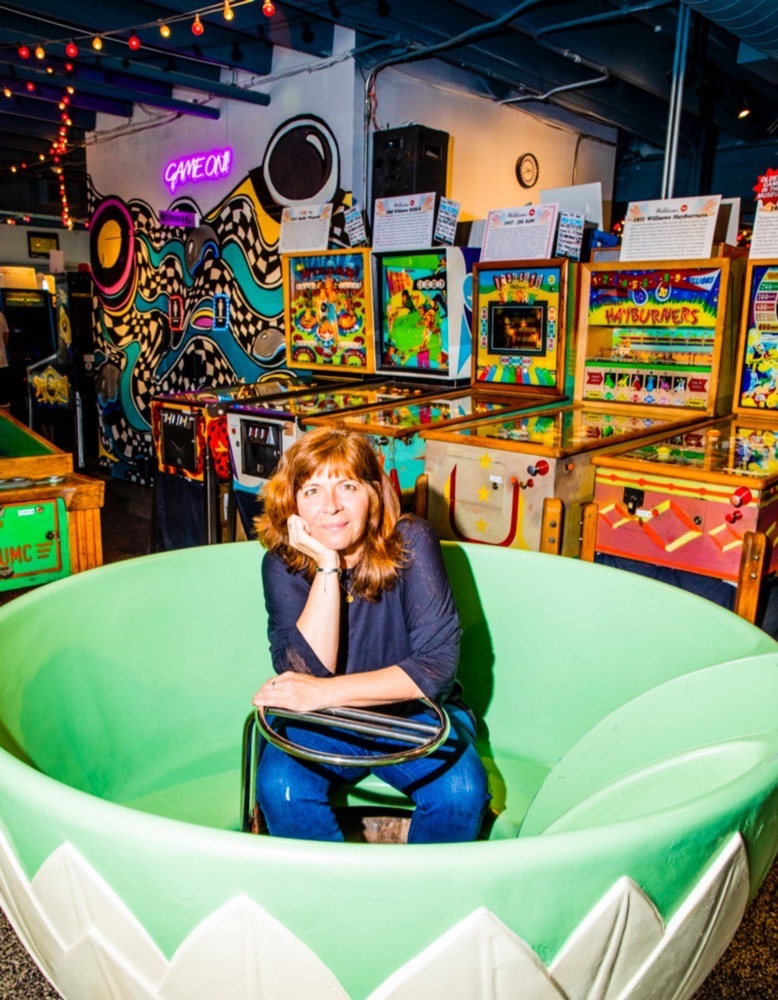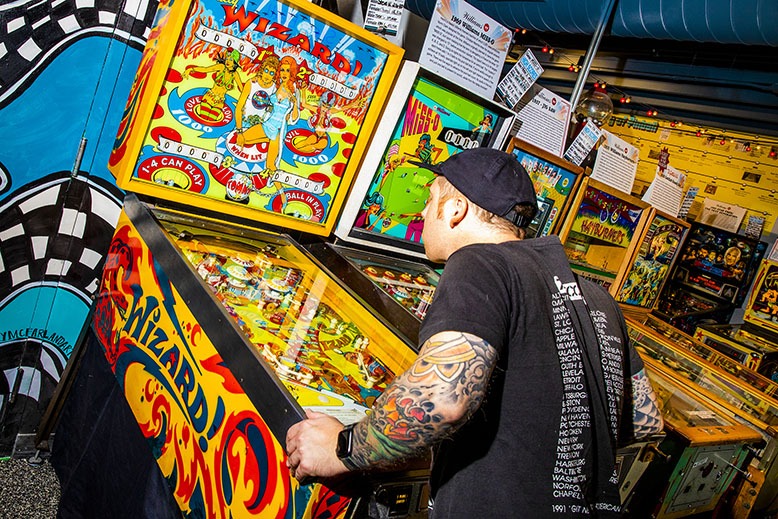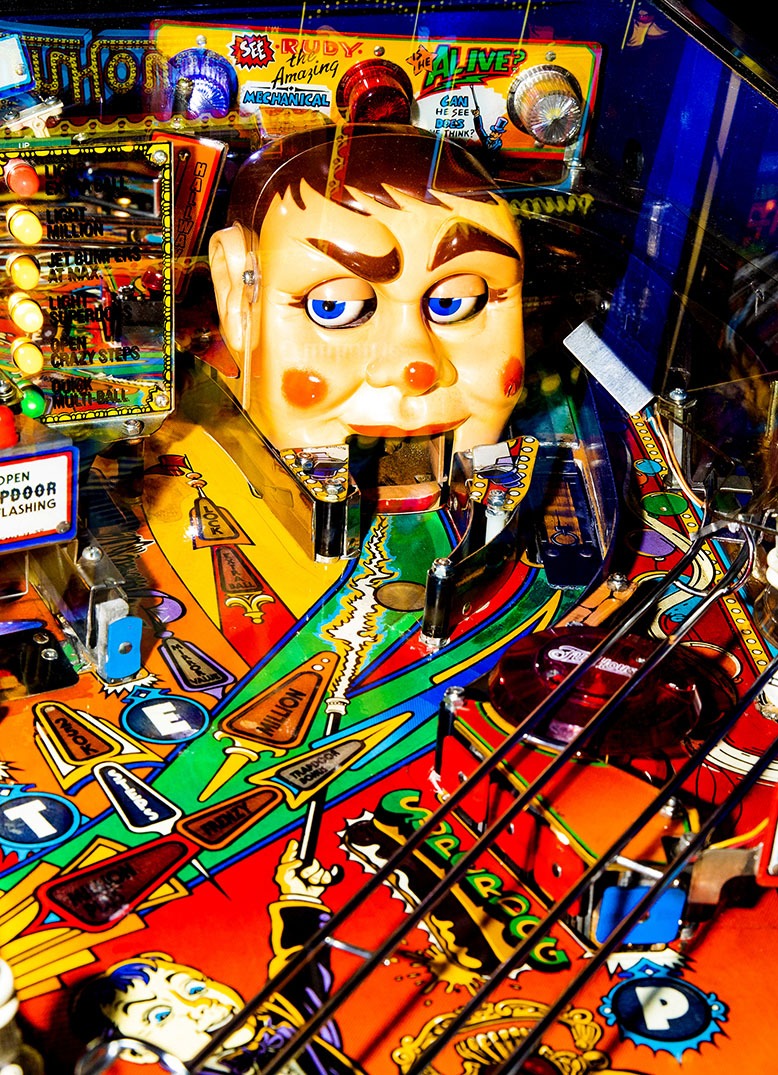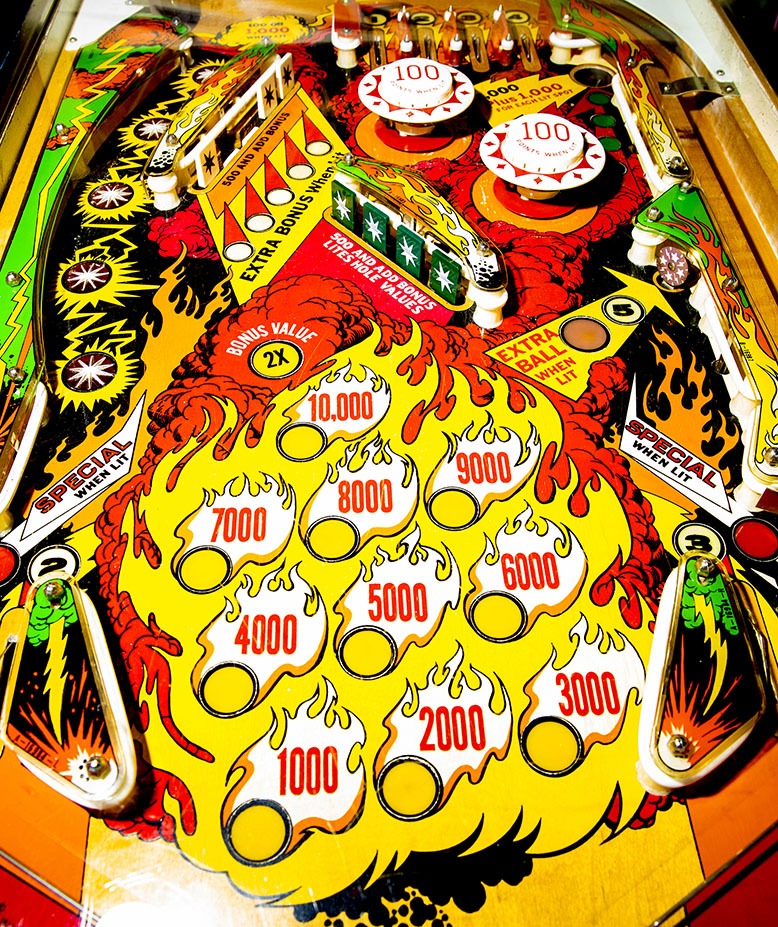
Patty Barber manages daily operations at Silverball Retro Arcade in Asbury Park. Photo: Krista Schlueter
Pings, clicks and boings fill the Silverball Retro Arcade in Asbury Park. The satisfying clunk of Skee-Ball and the electro-melodies of Pac-Man mingle with the thwack and jangle of pinball. These are the sounds of fun.
First and foremost, Silverball Retro Arcade is a place to play games. New Jersey has its share of well-stocked arcades, from Game Vault in Morristown to the Yestercades locations in Westfield, Somerville and Red Bank, Lucky Snake in Atlantic City, Jilly’s Arcade in Ocean City, and Retro Arcade & Fascination in Wildwood. But with its scholarly emphasis on rare and vintage pinball machines, Silverball is also a lively museum, as well as a year-round destination on the boardwalk in Asbury Park. Silverball highlights about 200 pinball machines from a rotating collection of about 600. This is where the pinball cognoscenti go to play games.
“All year, people come here from across the country and the U.K.,” says Patty Barber. The senior vice president of Silverball, she manages the daily operations in Asbury Park. “We have one guy who comes up from Philly every week. We also host tournaments through the International Flipper Pinball Association every other month in the offseason.”

Silverball is a pinball lover’s paradise, highlighting about 200 pinball machines from its rotating collection of about 600. Photo: Krista Schlueter
In 2015, Silverball opened a second location in Delray Beach, Florida, where founder Rob Ilvento lives in the offseason. His pinball empire has humble origins, going back to its 2009 opening in the basement below Groovy Graveyard, a record store on Cookman Avenue in Asbury Park. It was a place to showcase his pinball collection. But Ilvento, a West Long Branch native who dropped out of Rutgers and founded Cluck U Chicken in New Brunswick in 1985, had a knack for knowing what would take off. When his elder daughter took a liking to pinball, Ilvento sensed the potential for a new audience for a game familiar to Baby Boomers and Gen X’ers.
In 2010, Silverball moved to the boardwalk, where it became popular with tourists and beachgoers. (“If you go to Asbury Park, you’ve gotta go there,” Ilvento says.) It cultivated a following of serious players through its VIP membership, which offered a discount on admission and other benefits for subscribers. Paul Rubin, a pinball aficionado who lives in the Laurence Harbor section of Old Bridge, hits the arcade at least once a week. “The attitude at Silverball is wonderful,” Rubin says. “They’re very friendly, they’re happy to see you, and they have some very, very rare machines.”

People come to play games at Silverball from across the country and the U.K. Photo: Krista Schlueter
Among those rarities, Ilvento is proud to include a Kiss machine, which Bally introduced in 1979 in tribute to the hard rock band with the painted faces. Among the oldest machines at Silverball is Knockout, a 1950 boxing-themed game by Gottlieb. Ilvento himself loves the Bally machines from the 1960s, along with a favorite from childhood: Evel Knievel, Bally’s 1977 tribute to the daredevil stuntman.
Rubin, 72, has been playing pinball since childhood. “My great-grandfather lived in the Asbury Park area, and he’d give us handfuls of pennies and nickels for the arcade,” Rubin says. “In 1967, I was a lifeguard in Belmar, and there was an arcade in town where I’d play. When pinball took off again with Silverball, I decided to start playing in tournaments.”
Rubin advises newcomers to the game to start slowly and keep practicing. “You can even go to YouTube and learn and practice basic moves,” Rubin says. “It’s like learning to play an instrument.”

Game design delivers an eyeful, whatever the score. Photo: Krista Schlueter
At Silverball, a placard hangs above each pinball machine extolling its particular virtues and putting it in historical context. The placard for Melody, a 1966 pinball game by Gottlieb, credits Ed Krynski as the designer and Art Sternholm as the artist, explaining, “This game parallels the classic Gottlieb game Kings and Queens, which is in the museum,” and adding helpful hints: “If you hit the four numbers in one color sequence, the matching eject hole randomly lights to score an extra ball. A lot of points will be awarded if you land in the left hole as the ball is advanced to the right and then ejected to the flipper.”
“I knew people would appreciate the beauty of these machines,” Ilvento says. “It’s art that you can interact with.”
Of course, there’s a difference between the way someone like Rubin interacts with the art and the way your average 10-year-old smacks the flippers and yanks on the plunger. Commercial pinball machines take a lot of abuse and, therefore, need a lot of upkeep. That’s where Tim Sullivan, a 28-year-old from Keansburg, comes in. As operations manager for Silverball, he is in charge of keeping the tech in working order. Tasks include vacuuming the interior of the pinball cabinet, the box-like body that holds the play field, to reduce damage from dust, as well as performing minor repairs such as replacing the coil on a plunger or tightening a flipper.

Some machines are older than ace technician Tim Sullivan, 28. Photo: Krista Schlueter
Sullivan also fully restores pinball machines for Silverball. When necessary, a part can be cannibalized from a machine that is beyond repair, but, he says, most parts are commercially available. Working on a 300-pound pinball machine is a lot like being an auto mechanic, he says.
“It’s fun to restore a pinball machine, remove the filth, and bring it back to life,” Sullivan says. He is mostly self-taught. “I’ve been around pinball all my life,” says Sullivan, whose father repairs pinball machines, slot machines and jukeboxes. “I used to go on service calls with my dad.” The younger Sullivan can rattle off arcane details about pinball machines: “There is a mile of wire in a typical game.”
Barber considers Sullivan a wunderkind. “He can hear a strange noise from across the building, know what’s wrong and on which machine,” she says. As a player, Sullivan favors pinball games from the 1990s, such as Getaway, by Williams, and Creature From the Black Lagoon, by Bally, both released in 1992. He holds the high score on many machines at Silverball. Among modern games, he is intrigued by anything made by Jersey Jack, founded in 2011 in Lakewood and now a competitor to Stern, the last of the classic American pinball companies. Jersey Jack designed and manufactured its games in Lakewood, but moved to Elk Grove Village, Illinois, in 2020 to be closer to Chicago, long the center of the industry.

“It’s art that you can interact with,” Silverball founder Rob Ilvento says of the arcade’s game machinery. Photo: Krista Schlueter
Rubin has a soft spot for the pinball machines of his youth, but he also eagerly follows new releases by Jersey Jack. In Rubin’s opinion, Stern games are overrated. “Jersey Jack is like a Cadillac,” Rubin says. “Stern is like a Chevy.”
Reached by phone while at a pinball event in Paris, Jack “Jersey Jack” Guarnieri likened his company’s mission to a Broadway production. “You want to tell a story of what the game is,” says Guarnieri, who lives in Toms River. “We need to write a whole script for the speech calls. For Toy Story 4 [2022], we hired Tim Allen and Tom Hanks’s brother to record them: ‘Shoot the ramp!’ and ‘Multi-ball!’ and so on. And we need to hire good artists. It’s sensory overload.”
Jersey Jack releases a new game about every year. The first was Wizard of Oz in 2013, the theme of which Guarnieri hoped would appeal to women and young people. The guitarist Slash has purchased Jersey Jack pinball machines for his home, so Guarnieri approached him about creating a Guns N’ Roses machine, which was released in 2020. “We licensed 22 songs for that,” Guarnieri says.
Jersey Jack machines are known for innovations such as LCD screens on both the play field and the upright panel called the back box. There are headphone jacks for full immersion and cameras in the back box to take selfies.
Silverball does not arrange its machines chronologically: Gottlieb’s Melody from 1966 stands next to Jersey Jack’s Pirates of the Caribbean from 2018. But the arcade makes sure that the games most sought by patrons are on the floor. Among the most popular this year is Jersey Jack’s latest release, The Godfather 50 Years, released in 2023 to commemorate the classic 1972 Francis Ford Coppola film. “It’s important to have places like Silverball,” Guarnieri says. “It’s important to have physical public locations to play games. That’s how interest in the games will grow.”

Patty Barber rarely gets to sit down on the job. Photo: Krista Schlueter
Anticipating growth, the arcade expanded in 2022, adding about 500 square feet, for a total of about 4,500 square feet, by taking over the adjacent space that had previously housed the restaurant Pop’s Garage. “We took the kitchen out of the game area to make more room for games and to space things out,” Barber says. Silverball also moved the private-party area from the middle of the game floor to its own separate area.
Ilvento would like Silverball to grow even more. He has his eye on the Fourth Avenue pavilion. “That building has 16,000 square feet on the ground level and 16,000 square feet upstairs,” he says. “That would make us the biggest arcade in the world. And we can handle it! Some of our winter weeks are even busier than the first few weeks of summer.”
Kelly-Jane Cotter is a veteran journalist who grew up grooving on the arcades of Asbury Park and Beach Haven.
No one knows New Jersey like we do. Sign up for one of our free newsletters here. Want a print magazine mailed to you? Purchase an issue from our online store.



